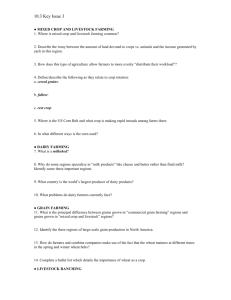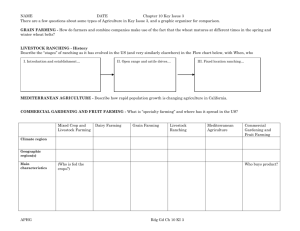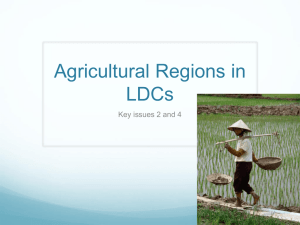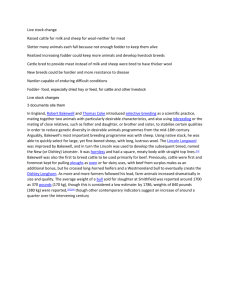Intensive Subsistence Agriculture
advertisement
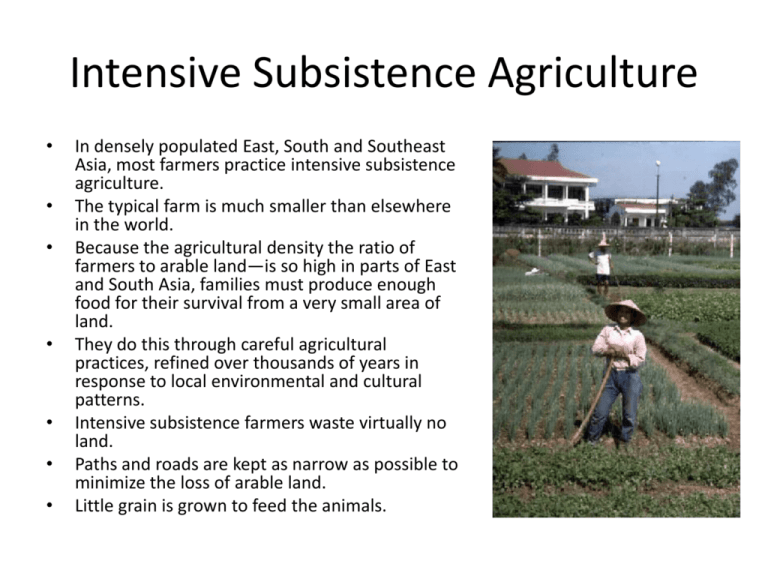
Intensive Subsistence Agriculture • • • • • • • In densely populated East, South and Southeast Asia, most farmers practice intensive subsistence agriculture. The typical farm is much smaller than elsewhere in the world. Because the agricultural density the ratio of farmers to arable land—is so high in parts of East and South Asia, families must produce enough food for their survival from a very small area of land. They do this through careful agricultural practices, refined over thousands of years in response to local environmental and cultural patterns. Intensive subsistence farmers waste virtually no land. Paths and roads are kept as narrow as possible to minimize the loss of arable land. Little grain is grown to feed the animals. World Rice Production Fig. 10-6: Asian farmers grow over 90% of the world’s rice. India and China alone account for over half of world rice production. Wet Rice Production • Growing rice involves several steps: First, a farmer prepares the field for planting, using a plow drawn by water buffalo or oxen. • The use of a plow and animal power is one characteristic that distinguishes subsistence agriculture from shifting cultivation. • Then the plowed land is flooded with water. . . from rainfall, river overflow, or irrigation. • The flooded field is called a sawah in the Austronesian language widely spoken in Indonesia, including Java. • Europeans and North Americans frequently, but incorrectly, call it a paddy, the Malay word for wet rice. • Wet rice is most easily grown on flat land, because the plants are submerged in water much of the time. Double cropping • One method of developing additional land suitable for growing rice is to terrace the hillsides of river valleys. • Land is used even more intensively in parts of Asia by obtaining two harvests per year from one field, a process known as double cropping. • Double cropping is common in places having warm winters but is relatively rare in India, where most areas have dry winters. • Normally, double cropping involves alternating between wet rice and wheat, barley, or another dry crop, grown in the drier winter season. Chinese Communes • In milder parts of the region, more than one harvest can be obtained some years through skilled use of crop rotation. • Since the (Chinese) Communist Revolution in 1949, the government organized agricultural producer communes. • By combining several small fields into a single large unit, the government hoped to promote agricultural efficiency. • China has dismantled the agricultural communes. • The communes still hold legal title to agricultural land, but villagers sign contracts entitling them to farm portions of the land as private individuals. • Reorganization has been difficult because infrastructure was developed to serve large communal farms rather than small, individually managed ones. Key Issue 3: Agriculture in Developed Countries • • • • • • • Mixed crop and livestock systems Dairy farming Grain farming Livestock ranching Mediterranean agriculture Commercial gardening and fruit farming Plantation farming Mixed Crop and Livestock Farming • Mixed crop and livestock farming is the most common form of commercial agriculture in the United States west of the Appalachians and east of 98° west longitude and in much of Europe from France to Russia. Characteristics of Mixed Crop and Livestock Farming • The most distinctive characteristic of mixed crop and livestock farming is its integration of crops and livestock. • Most of the crops are fed to animals rather than consumed directly by humans. • Mixed crop and livestock farming permits farmers to distribute the workload more evenly through the year... (and) reduces seasonal variations in income. Crop Rotation Systems • Mixed crop and livestock farming typically involves crop rotation. • Crop rotation contrasts with shifting cultivation, in which nutrients depleted from a field are restored only by leaving the field fallow (uncropped) for many years. • A two-field crop-rotation system was developed in Northern Europe as early as the fifth century A.D. • Beginning in the eighth century, a three-field system was introduced. • Each field yielded four harvests every six years, compared to three every six years under the two-field system. • A four-field system was used in Northwest Europe by the eighteenth century. • Each field thus passed through a cycle of four crops: root, cereal, rest crop, and another cereal. • Cereals were sold for flour and beer production, and straw was retained for animal bedding. • Root crops were fed to the animals during the winter. • Clover and other “rest” crops were used for cattle grazing and restoration of nitrogen to the soil. World Corn (Maize) Production Fig. 10-7: The U.S. and China are the leading producers of corn (maize) in the world. Much of the corn in both countries is used for animal feed. World Milk Production Fig 10-8: Milk production reflects wealth, culture, and environment. It is usually high in MDCs, especially production per capita, and varies considerably in LDCs. Why Dairy Farms Locate Near Urban Areas • • • • • • Dairying has become the most important type of commercial agriculture in the first ring outside large cities because of transportation factors. The ring surrounding a city from which milk can be supplied without spoiling is known as the milkshed. Improvements in transportation have permitted dairying to be undertaken farther from the market. As a result, nearly every farm in the U.S. Northeast and Northwest Europe is within the milkshed of at least one urban area. Some dairy farms specialize in products other than milk. Originally, butter and cheese were made directly on the farm, primarily from the excess milk produced in the summer, before modern agricultural methods evened the flow of milk through the year. Dairy Production in the U.S. Fig. 10-9: Milk production is widely dispersed because of its perishability, but cheese production is far more concentrated. Problems for Dairy Farmers • Like other commercial farmers, dairy farmers face economic problems because of declining revenues and rising costs. • Dairy farming is labor-intensive. • Dairy farmers also face the expense of feeding the cows in the winter, when they may be unable to graze on grass. • The number of farms with milk cows declined in the United States by twothirds between 1980 and 2000. • The number of dairy cows declined by only one-eighth, and production actually increased by one-fourth-—yields per cow increased substantially. Grain Farming • Commercial grain agriculture is distinguished from mixed crop and livestock farming because crops on a grain farm are grown primarily for consumption by humans rather than by livestock. • Wheat generally can be sold for a higher price than other grains and it has more uses as human food. • Because wheat has a relatively high value per unit weight, it can be shipped profitably from remote farms to markets. World Wheat Production Fig. 10-10: China is the world’s leading wheat producer, but the U.S. and Canada account for about half of world wheat exports. Importance of Wheat • Wheat is grown to a considerable extent for international trade and is the world’s leading export crop. • The ability to provide food for many people elsewhere in the world is a major source of economic and political strength for the United States and Canada. Livestock Ranching • Ranching is the commercial grazing of livestock over an extensive area, practiced in more developed countries, where the vegetation is too sparse and the soil too poor to support crops. • The importance of ranching in the United States extends beyond the number of people who choose this form of commercial farming because of its prominence in popular culture. • Cattle ranching in Texas, though, as glamorized in popular culture, actually dominated commercial agriculture for a short period—from 1867 to 1885. Beginning of U.S. Cattle Ranching • Cattle were first brought to the Americas by Columbus on his second voyage. • Living in the wild, the cattle multiplied and thrived on abundant grazing lands on the frontiers of North and South America. • Immigrants from Spain and Portugal—the only European countries with a tradition of cattle ranching—began ranching in the Americas. • Cattle ranching in the United States expanded because of demand for beef in the East Coast cities during the 1860s. • Ranchers who could get their cattle to Chicago were paid $30 to $40 per head, compared to only $3 or $4 per head in Texas. The Chisholm Trail Fig. 10-11: The Chisholm Trail became famous as the main route for cattle drives from Texas to the railheads in Kansas. Meat Production on Ranches Fig. 10-12: Cattle, sheep, and goats are the main meat animals raised on ranches. Range Wars • The U.S. government, which owned most of the land used for open grazing, began to sell it to farmers to grow crops. • For a few years the ranchers tried to drive out the farmers. • The farmers’ most potent weapon proved to be barbed wire, first commercially produced in 1873. • Ranchers were compelled to buy or lease land to accommodate their cattle. • Sixty percent of cattle grazing today are on land leased from the U.S. government. Changes in Cattle Breeding • Ranchers were also induced to switch from cattle drives to fixed- location ranching by a change in the predominant breed of cattle. Longhorns were hardy animals but the meat of longhorns was of poor quality. • New cattle breeds introduced from Europe, such as the Hereford, offered superior meat but were not adapted to the old ranching system. • These breeds thrived once open grazing was replaced by fixed ranching, and long-distance trail drives and rail journeys to Chicago gave way to short rail or truck trips to nearby meat packers. • With the spread of irrigation techniques and hardier crops, land in the United States has been converted from ranching to crop growing. • Cattle are still raised on ranches but are frequently sent for fattening to farms or to local feed lots. Ranching outside the United States • Commercial ranching is conducted in other more developed regions of the world. • Ranching is rare in Europe, except in Spain and Portugal. • In South America a large portion of the pampas. . . are devoted to grazing cattle and sheep. • The relatively humid climate on the pampas provides more shoots and shrubs on a given area of land than in the U.S. West. • Land was divided into large holdings in the nineteenth century, in contrast to the U.S. practice. • Ranching has declined in Argentina because growing crops is more profitable except on very dry lands. Mediterranean Agriculture • • • • • • • • Mediterranean agriculture exists primarily in the lands that border the Mediterranean Sea. Farmers in California, central Chile, the southwestern part of South Africa, and southwestern Australia practice Mediterranean agriculture as well. Every Mediterranean area borders a sea. Prevailing sea winds provide moisture and moderate the winter temperatures. Summers are hot and dry. The land is very hilly. Farmers derive a smaller percentage of income from animal products in the Mediterranean region than in the mixed crop and livestock region. Some farmers living along the Mediterranean Sea traditionally used transhumance to raise animals, although the practice is now less common. Mediterranean Crops • • • • • • • • Most crops in Mediterranean lands are grown for human consumption rather than for animal feed. Horticulture—which is the growing of fruits, vegetables, and flowers—and tree crops form the commercial base of the Mediterranean farming. In the lands bordering the Mediterranean Sea, the two most important cash crops are olives and grapes. Despite the importance of olives and grapes to commercial farms bordering the Mediterranean Sea, approximately half of the land is devoted to growing cereals, especially wheat for pasta and bread. Cereals occupy a much lower percentage of the cultivated land in California than in other Mediterranean climates. The rapid growth of urban areas in California, especially Los Angeles, has converted high-quality agricultural land into housing developments. The loss of farmland has been offset by expansion of agriculture into arid lands. However, farming in drylands requires massive irrigation to provide water. Commercial Gardening and Fruit Farming • Commercial gardening and fruit farming is the predominant type of agriculture in the U.S. Southeast, frequently called truck farming, because “truck” was a Middle English word meaning bartering or the exchange of commodities. • Truck farms grow fruits and vegetables. • Some of these fruits and vegetables are sold fresh to consumers, but most are sold to large processors. • Truck farms are highly efficient large-scale operations that take full advantage of machines at every stage of the growing process. • Labor costs are kept down by hiring migrant farm workers. • A handful of farms may dominate national output of some fruits and vegetables. • A form of truck farming called specially farming has spread to New England, growing crops that have limited but increasing demand among affluent consumers. Plantation Farming • The plantation is a form of commercial agriculture found in the tropics and subtropics, especially in Latin America, Africa, and Asia. • Plantations are often owned or operated by Europeans or North Americans and grow crops for sale primarily in more developed countries. • A plantation is a large farm that specializes in one or two crops. • Among the most important crops are cotton, sugarcane, coffee, rubber, and tobacco, cocoa, jute, bananas, tea, coconuts, and palm oil. • Because plantations are usually situated in sparsely settled locations, they must import workers. • Managers try to spread the work throughout the year to make full use of the large labor force. Key Issue 4: Economic Issues of Agriculture • Economic issues of commercial farmers – Access to markets – Overproduction – Sustainable agriculture • Economic issues of subsistence farmers – Population growth – International trade • Increasing food supply Access to Markets • Two economic factors influence the choice of crops (or livestock) by commercial farmers: access to markets and overproduction. • Because the purpose of commercial farming is to sell produce off the farm, the distance from the farm to the market influences the farmer’s choice of crop to plant. • Geographers use the von Thünen model to help explain the importance of proximity to market in the choice of crops on commercial farms. Von Thünen Model Fig. 10-13: Von Thünen’s model shows how distance from a city or market affects the choice of agricultural activity in (a) a uniform landscape and (b) one with a river. Example of Von Thünen’s Model • The example shows that a farmer would make a profit growing wheat on land located less than 4 kilometers from the market. • Beyond 4 kilometers, wheat is not profitable, because the cost of transporting it exceeds the gross profit. • More distant farms are more likely to select crops that can be transported less expensively. Application of Von Thünen’s Model • Von Thünen based his general model of the spatial arrangement of different crops on his experiences as owner of a large estate in northern Germany during the early nineteenth century. • He found that specific crops were grown in different rings around the cities in the area. • Von Thünen did not consider site or human factors in his model, although he recognized that the model could vary according to topography and other distinctive physical conditions. • The model also failed to understand that social customs and government policies influence the attractiveness of plants and animals for a commercial farmer. • Although von Thünen developed the model for a small region with a single market center, it also applies to a national or global scale.
